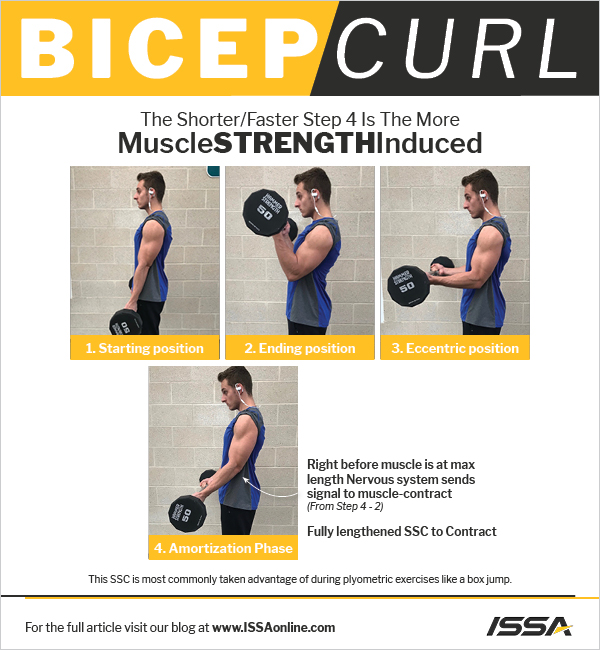Among many other variables, lifting speed, or tempo, is an important consideration for hypertrophy and strength goals.
How fast your client performs reps will have an impact on their goals:
-
Slow lifts for hypertrophy
-
Faster lifts for strength
Beyond the usual variables—frequency, intensity, time, and type—tempo plays an integral part in your program design. Let’s take a look at slow tempo workouts first.
Slow Tempos Produce Big Muscles
If your client’s main goal is hypertrophy, slower rep tempos are best.
The reason for this is that during a movement performed at minimal velocity you stress balance, mobility, and training of the stabilizer muscles.
When the muscle sustains tension over a longer period of time, adaptations are triggered that promote growth in size. Let’s dig a little deeper.
More muscle tension and volume is what leads to muscle breakdown, recovery, and ultimately growth. So, if you reduce the rep speed to a slow and more controlled tempo, you increase the muscle tension.
The higher the muscle tension, the more growth you get.
Studies have also found that controlled, slower eccentric repetitions are more effective at stimulating growth hormone production than the concentric phase, which in turn leads to muscle growth (1).
Generally, for the purposes of increasing muscle size, when lifting weights, the length of a set should be longer than it would be if you were focusing on strength.
In this case, the number of reps is not a determining factor of muscle growth. Putting more emphasis on the eccentric movement will allow for more overload and resistance creating more muscle damage. This leads to greater muscle growth.
An effective method to enhance this muscle tension is performing isometric exercise-contractions. These types of movements can aid in keeping constant tension on the muscle.
What is Considered a Slow Tempo?
A great way to educate clients on what a slow and controlled tempo might look like is using the 4 Point Tempo Component. Let’s use a bench press tempo example: the lowering of the weight-eccentric portion should last no shorter than 3 seconds, the bottom position-stretch position should last no more than 0 seconds, the raising of the weight-concentric portion should last no less than 2 seconds, and the top position-contracted position should last no more than 0 seconds.
List this bench press tempo example as 3:0:2:0. These are simply guidelines, they can and should vary from client to client along with each exercise.
Takeaway: For hypertrophy goals, use lighter weights, and perform more reps at a slower pace.
Greater Speed Produces Greater Strength
For the goal of increasing strength, you want your client to speed it up. The faster your client performs a rep, the more they will be able to improve their one rep max.
This has been proven with specific exercises, including the bench press. The faster you perform a rep, the greater increase you will see in strength. Training with heavy loads and maximal output triggers fast-twitch muscle fibers.
So how does this work? For bigger, compound lifts in particular, the faster you move through the repetition, the quicker you activate the fast twitch muscle fibers. You can actually skip over the slow twitch fibers and go straight to fast twitch, for greater strength gains.
This helps increase connective tissue strength allowing greater force production amongst muscles.
Additionally, a faster tempo takes advantage of the stretch shortening cycle for building strength.
What’s the Stretch Shortening Cycle?
This is what occurs when your muscle gets to the end of the eccentric phase of a rep, at its maximum length. At this point, your nervous system will send a signal to the muscle to tell it to contract. This happens to help prevent injuries. So, your muscle automatically goes from stretching to shortening.
To gain muscle strength, that period of time should be as short as possible. The shorter it is the more power your muscles use during the amortization phase. And, the more muscle fibers will be engaged.
In addition to moving at a faster tempo, greater strength gains happen with more weight and fewer reps. Exercise movements encouraged to be in most weight training programs include the following:
-
Deadlift
-
Weighted pull-up
-
Barbell bench press
-
Barbell squat
These are just a few of the best strength training exercises out there, especially for an athlete or Olympic lifters, due to the potential of a one-repetition maximum.
Takeaway: For strength goals, use heavier weights and perform fewer reps at a faster tempo.
When Should You Use Tempo Training?
It’s important that your clients realize there are sacrifices to make when you choose one goal over another. For instance, when you have a client work with heavier weights, faster, they’ll get stronger, but they will sacrifice hypertrophy.
Make sure you know what your clients’ want to get out of workouts, and you can add in either speed or slow movements to help them reach their goals.
If you are looking to expand your current knowledge beyond the scope of just a personal training certification, then you should consider ISSA’s Strength and Conditioning specialization. One of many learning opportunities in this course is gaining an understanding of the best exercises to increase endurance, flexibility, strength, power, and speed.

Click HERE to download this handout and share with your clients!


